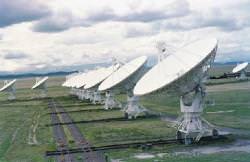Supermassive black holes lurk at the heart of galaxies, containing the mass of millions of stars. Stellar mass black holes can contain the mass of a few suns. But astronomers have been perplexed why they haven’t been able to turn up intermediate mass black holes, containing merely hundreds or thousands of times the mass of our Sun.
Well, now they have. Astronomers using the NSF’s Very Large Array (VLA) radio telescope have turned up a globular cluster in the Andromdeda Galaxy (M31) that seems to contain a black hole with the mass of 20,000 times the mass of the Sun; one of these long-sought intermediate black holes.
Researchers originally detected X-rays emitted from this globular cluster, and then did follow up observations in the radio spectrum to confirm that a high mass, compact object is inside the cluster. Although the best explanation is a black hole, it could also be a cluster of compact objects, like neutron stars and black holes. The quantity of radio emissions coming from the object fits the curve perfectly between stellar and supermassive black holes.
Original source: NRAO News Release

